We’re sure that many of you look at that headline and say “is this a b-a-a-a-ad joke?” Okay, THAT one definitely was! But the fact is that it wasn’t all that long ago that many of the socks that we saw, even with American brand names, were produced offshore. And the quality was sometimes spotty (at best). But in the last few years, we’ve seen more and more American made Merino wool socks in our favorite shops. What has changed?
Simply put, the wide acceptance of Merino wool had made consumers recognize the value of a better quality sock. Sure, there are $5 specials out there, but it’s pretty obvious from a quick look that they aren’t built the same; looser knits, bulging seams, lower quality materials. The granddaddy of the Merino manufacturers in this country is Smartwool; all of us have owned a variety of them over the years. But, most of us have tried out other brands in the past few years, and become hooked on one or another. We decided to pool our information, see what the newest thing was from each of the manufacturers, trade socks back and forth, even wash them once in a while, and see what we could find out.
As we wandered around, we focused on several characteristics. One was fit; with a variety of different size and shape feet, did a given sock work for everyone? Another was, for lack of a better term, “unstinkability;” the quality of being able to wear them multiple days in a row on a hiking trip without scaring the local skunks away. Third was durability; even though we weren’t able to give them a multi-year test, it’s generally clear after a double handful of uses whether they’re showing signs of premature wear or not. And finally, the intangible “comfort;” did the socks make people want to hide them in their mattress and claim that an AT through hiker had stolen them? After a summer of abusing and trading, here’s what we found out, organized alphabetically by manufacturer.
Dahlgren
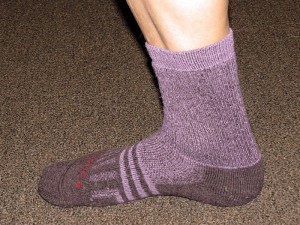
Okay, some cheating here; Dahlgren uses Alpaca blended with Merino. What’s the difference? Well…Alpaca is sort of a New World camel, much like a llama. Why use it? Simple; it’s one of the softest, silkiest natural fibers available. While Merino is remarkably non-itchy, Alpaca is simply a luxury. But, pure Alpaca is a very slippery material, and you want your socks to actually stay on your feet; thus, the blend. Dahlgren’s belief is that the combination of those wools along with areas of synthetic yarns creates the best blend of moisture absorption and wicking available. Our experience is that, in fact, they do wick well, and are VERY “comfy & cozy,” as one tester put it. These are the socks that you’ll wear around the house instead of slippers while sipping your cocoa. Downside? The knit wasn’t as tight as some of the other brands, so not quite as good for high-performance applications, and the socks show some early signs of pilling, so likely not as long life. But, everything in life is a tradeoff, and all of us loved the feel of them on our feet. UPDATE: Kris Dahlgren, president of Dahlgren Footwear, contacted us to let us know that they have updated their lineup. So, while this WAS the “Backpacking” model, it’s now “Field & Forest;” it’s aimed for, well, less abusive use than what we tend to give socks. Their new models that are aimed at backpackers are the MultiPass and MultiPass Light. We haven’t had the opportunity to test them, but based on the original socks, it’s likely that they’ll be a well made sock.
Darn Tough
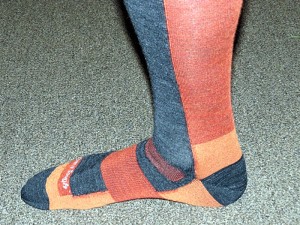
The name says it all. If Chuck Norris were a sock, he’d be a Darn Tough, and probably slap you upside the head for questioning if they’re tough enough. Warranty? Yeah, try to wear them out…if you manage it, send ’em back and they’ll send you another pair. Period. (Caveat: We had one pair fail, sent them back, and they sent a very different model as a replacement.) Now, we’ve had socks that wore like iron before, and felt like it; we HOPED we could kill them. Not these; they’re solidly comfortable. No, they don’t have the silkiness of the Dahlgrens or made-for-you fit of the FITS, but if you want to climb Everest without fear of sock failure (or spend a summer traveling through Europe with one pair of socks), these are your babies. We’ve used them, abused them, and they win. The firm, tight knit that gives them durability also makes them excellent for applications such as downhill skiing where you don’t want a lot of loft in the sock to mess with the fit of your boots. They also were excellent for multi-day trips, retaining their shape and feel better than any other in this group.
FITS
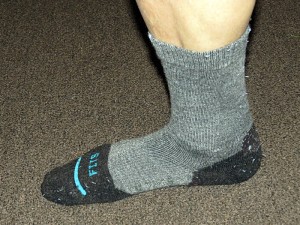
Never was a name better chosen; ALL testers were amazed at the way FITS socks wrapped themselves around the weirdest shaped feet like they were knitted for them. They claim some interesting things about their design parameters, including the “Dynamic Toe Cup” that conforms to the natural shape of the toes for a better fit. Well…we’re cynical about that in concept, since our testers have toes that range from short and squat to long and skinny, straight across the ends to pointy as all getout, almost like a human hand. There’s no real similarity, yet the FITS do, in fact, fit all of us beautifully. They’re not our top choice for multi-day backpacking trips; the density or makeup of the yarn seems to allow us to feel the buildup of salt and clamminess faster than the other choices. But, for single day events, we simply haven’t found anything as comfortable! Even more than the Dahlgrens, they show early pilling (visible in the photo), so durability is the tradeoff for such a spectacular feel.
Smartwool
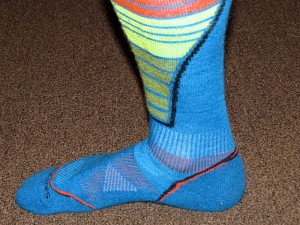
We all owe a debt of gratitude to Smartwool; they’re the granddaddy of Merino socks in the USA, and popularized them back in 1994 when synthetics roamed the earth. It may be a bit far-fetched to say that without them, none of these other companies would be making Merino socks, but we wouldn’t bet against it, either. Most of us have a drawer full of Smartwool socks that have survived years of use…and some of them are still good socks. But, they’re a bit dated against the newcomers. Has Smartwool the company kept up?
Darned tootin’ right, they have. We were a bit apprehensive about what we’d find, but when the new PhD socks came walking through the door, we stopped worrying. These aren’t basic, everyday socks; they’re high tech, with varying padding, stretch, fit. And, according to Smartwool, they provide compression benefits. We continue to be skeptical about the value of compression during exercise (although we have found compression benefits for pre and post activity), but…hey, when it’s included in our regular socks, there’s certainly no downside! As befits a large company, the product range is broad; we tested them for hiking, downhill skiing, and backcountry skiing, with universally excellent results. Wear, comfort, and multi-day use were well balanced; they may not be the best in any one category, but they’re near the top in all. Bonus: They’re fun to look at. Bright colors and patterns abound; does that affect quality? Obviously not, but hey, in a world filled with grays and blacks, an extra smile or two never hurts!
Teko
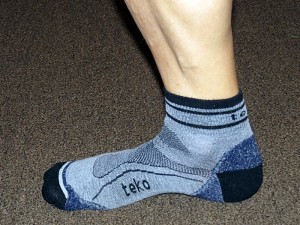
Less a sock than a concept, Teko’s focus isn’t just on making great socks, but as much or more on being eco-friendly. So, their headquarters are powered by renewable energy, they use locally sourced and/or organic wool, recycled polyester for the yarns, non-toxic dyes, etc. They’re also committed to the Fair Trade ideal, paying a fair wage to the wool producers in South America. You aren’t just buying socks, you’re saving the planet. Bizarrely enough, they’re actually a Scottish company, making socks in the USA; that’s a strange take on “exporting jobs!” We’ll take it, though, as it sounds like we’re becoming a global leader in sock manufacturing technology. Right?
The good news is that you’re also getting some very good socks. We only tested Teko cycling socks, but they were excellent, without caveats. A very tight knit was perfect for getting power to the pedals, but was still comfortable, conforming well to our feet. Durability was superb; even after multiple days of mountain biking and cyclocross racing, there was no sign of damage from all of the mud and grit, and no stretching or loosening of the cuff (incredibly important in keeping the grit from getting to your skin). We expect that we’ll continue to abuse them for a long time to come, and look forward to seeing if the hiking socks live up to the promise of these.
The Takeaway
We’re thrilled with the results of our testing, for two reasons. First, while we aren’t chest-thumping jingoists, we ARE happy to see American manufacturing producing quality like this. We haven’t found any socks in our testing from anywhere else that are any BETTER than these, and precious few that are as good. So, bravo to the mills! Second…wow, what a great range of American-made socks we have available to us now! After decades of synthetics that failed us in a variety of ways, to have such a range of more environmentally friendly, more comfortable, better-wearing options is sheer bliss. In fact, the range is even larger than shown here; while researching this article, we became aware of other brands (to be tested later!). We rely on our feet for pretty much everything we do (okay, maybe not so much for kayaking), and socks are our first point of contact; bad ones can make the best shoes and boots miserable and utterly ruin a trip, great ones can mean a long day leaves us tired but not footsore. If you haven’t tried any of the new generation of American made Merino wool socks, you owe it to yourself to give some of these a try; we promise that you’ll find a new favorite that will make your outdoor life more fun!



For a man in his eighties with swollen feet and ankles, and who has difficulty putting on his socks,do you think the FITS would be the way to go,or the Dalgrens? Would appreciate your opinion.
While we love both, the Dahlgren would be the better choice. The FITS use a very tight yarn configuration that makes them almost like a compression sock; that may have certain advantages, but would be a lot harder to put on. We tested the Dahlgren Forest & Field, and it had a much easier stretch to it, so we’d go that way in this case.